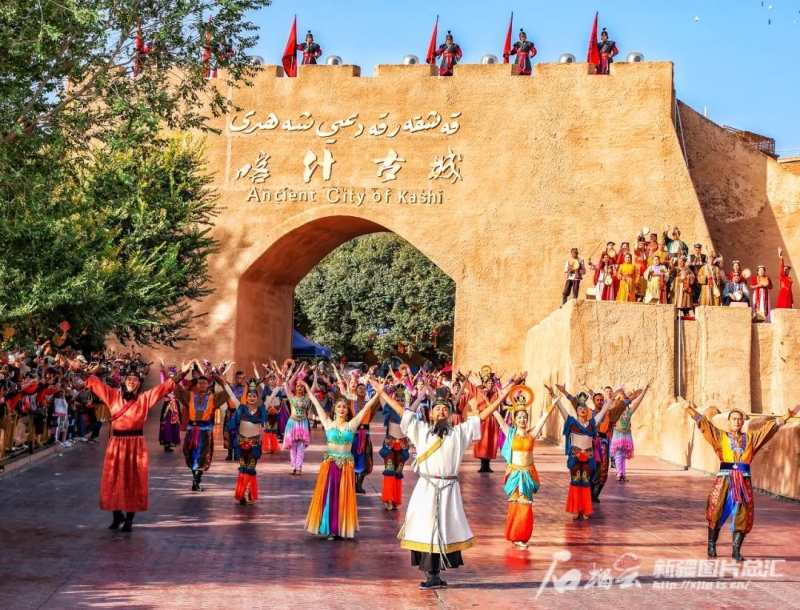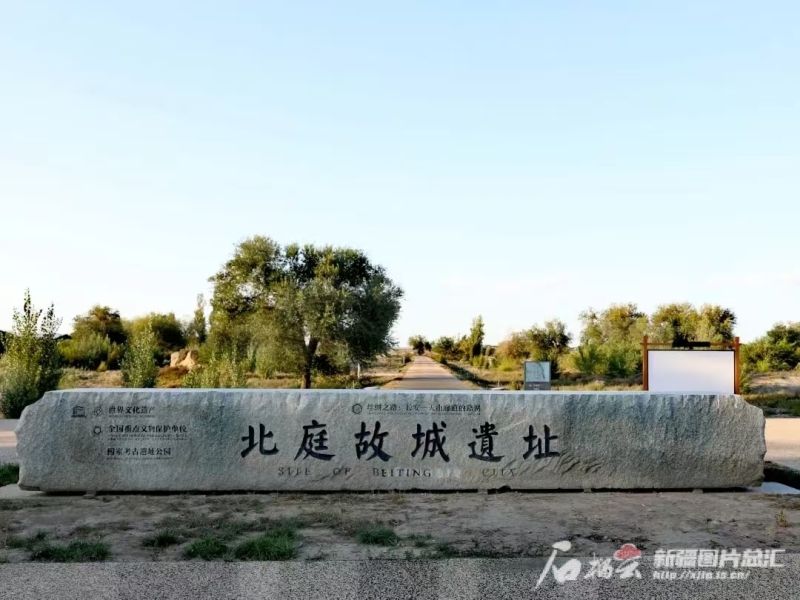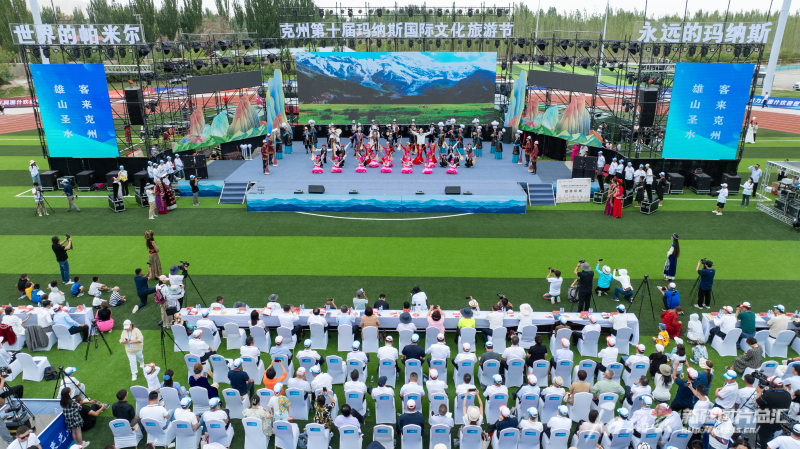Shiliuyun-Xinjiang Daily (Reporter Zhang Lei) news: "One who hasn't been to Kashi hasn't truly been to Xinjiang; One who hasn't visited the ancient city of Kashi hasn't truly been to Kashi." Kashi, a vital hub along the ancient Silk Road, boasts a history of urban construction spanning over 2,000 years. Within the ancient city of Kashi, numerous traditional dwellings stand quietly, bearing the mottled marks of over a century's worth of time. In recent years, thanks to efforts such as renovation, transformation and conservation, a steady stream of tourists have flocked here to relax and immerse themselves in the allure of Xinjiang's culture. The revitalization of these age-old structures owes much to the protective framework provided by local legislation such as the "Regulations on the Protection of the Ancient City of Kashi in the Xinjiang Uygur Autonomous Region."

File photo shows the opening performance of the ancient city of Kashi in Kashi Prefecture, northwest China’s Xinjiang Uygur Autonomous Region. (Photo by Ding Min)
This year's government work report proposes advancing the systematic protection of cultural heritage and enhancing the level of conservation, utilization, and archaeological research of cultural relics and intangible cultural heritage. In recent years, the Standing Committee of the People's Congress of the Xinjiang Uygur Autonomous Region has focused on key issues such as "what to protect," "who will protect it," and "how to protect it," accelerating the legalization process for the protection of historical and cultural heritage, safeguarding the historical roots of Xinjiang in accordance with the law. As a result, a series of regulations and ordinances have been enacted, including the "Regulations on the Protection of Famous Historical and Cultural Cities, Blocks, and Buildings in the Xinjiang Uygur Autonomous Region," the "Regulations on the Protection of Intangible Cultural Heritage in the Xinjiang Uygur Autonomous Region," and the "Regulations on the Protection of Uygur Muqam Art in the Xinjiang Uygur Autonomous Region." These legislative efforts have enabled the distinctive historical and cultural resources across Xinjiang to shine with even more brilliant splendor.
The millennium-old site holds the roots of culture
During the Qingming Festival holiday, the Beiting Ancient City Site in Jimsar County attracted visitors from various places. Here, they could appreciate a unique blend and clash of cultures and experience the vast and magnificent scenery beyond the Great Wall. "Walking through the ancient city of Beiting feels like traveling through a thousand years of history and witnessing the enduring vitality of China's excellent traditional culture," said Feng Hao, a tourist from east China's Shandong Province.
As the only national archaeological site park in China’s Xinjiang and one of the first batch of cultural heritage sites inscribed on the UNESCO World Cultural Heritage list, the conservation efforts for the Beiting Ancient City Site have accelerated in recent years. The integration of culture and tourism has injected vitality into its preservation, while technological advancements have helped restore its former glory. Moreover, legal protection has laid a solid foundation for this endeavor, playing an indispensable role.
On May 20, 2013, the "Regulations on the Protection of the Beiting Ancient City Site in Jimsar, Xinjiang" came into effect, marking the beginning of legislative protection for the Beiting Ancient City Site. "These regulations played a significant role in regulating and protecting the Beiting Ancient City Site in accordance with the law, but they are no longer suited to the current needs of protection and heritage preservation," said Li Zhong, director of the Legislative Affairs Commission of the Standing Committee of the Changji Hui Autonomous Prefecture People's Congress. On March 26 this year, the 19th session of the 14th Standing Committee of the People's Congress of the Xinjiang Uygur Autonomous Region passed the "Regulations on the Protection of the Beiting Ancient City Site in Changji Hui Autonomous Prefecture," opening a new chapter in the legal protection of the Beiting Ancient City Site.
The newly revised regulations explicitly state that the protection, management, and utilization of the Beiting Ancient City Site should adhere to the principle of "prioritizing protection, strengthening management, unearthing (its) value, making rational use (of it), and bringing cultural relics to life." Moreover, for the first time, technological protection methods such as "digital scanning, artificial intelligence, and virtual reality" have been incorporated into the provisions. The regulations also clarify activation pathways, including integration of culture and tourism, as well as research-oriented learning and educational initiatives.

File photo shows the site of the ancient city of Beiting in Changji Hui Autonomous Prefecture, northwest China’s Xinjiang Uygur Autonomous Region. (Photo by Xu Le)
Starting from the reality of Xinjiang, the Standing Committee of the Regional People's Congress has enacted legislation with distinctive features for the protection of historical and cultural heritage, which embodies typical regional characteristics and rich historical and cultural connotations. In Turpan City, more than 300 kilometers away from the Beiting Ancient City Site, the "Regulations on the Protection and Management of the Jiaohe Ancient City Ruins in Turpan, Xinjiang Uygur Autonomous Region" and the "Regulations on the Protection of Karez in Xinjiang Uygur Autonomous Region" (Karez, the underground irrigation system since ancient time in Xinjiang) have been implemented successively. These regulations not only highlight regional characteristics but also emphasize protection and inheritance, enabling historical relics that have spanned more than two thousand years to regain new vitality.
Zhuang Han, associate dean of the Law School at Xinjiang University, stated that thanks to local legislative protection, these historical and cultural heritages have become vivid textbooks that effectively convey the history of interactions, exchanges, and integration among various ethnic groups, proving that Chinese civilization has always remained vibrant and rejuvenated through embracing diversity.
The ancient villages retain beautiful nostalgia
Ancient and traditional villages encompass unique values of both natural and material cultural heritage, as well as abundant intangible cultural heritage value, and are thus referred to as "standing cultural relics and histories with vitality."
As of now, Xinjiang boasts four Chinese famous historical and cultural villages and 53 Chinese traditional villages, with eight villages in Mulei Kazak Autonomous County among them. However, with the rapid development of the economy and society, the protection of traditional villages in Mulei has encountered a series of "growing pains." How can we maintain the traditional style of ancient villages and preserve beautiful nostalgia?
On October 1, 2019, the "Regulations on the Protection of Traditional Villages in Mulei Kazak Autonomous County" came into effect. This is the first local regulation in Xinjiang aimed at protecting traditional villages, with specific protective provisions for "Balangfang" (a type of traditional local dwelling).
In Yueliangdi Village, the most representative traditional village in Mulei, there were instances where the original architectural features were damaged during renovations or rebuilds of Balangfang (a type of traditional dwelling) by villagers. "The regulations have helped preserve Balangfang, maintaining its traditional style and safeguarding our nostalgia for the hometown," said Liu Shuqin, a deputy to the Changji Hui Autonomous Prefecture People's Congress and a villager from Yueliangdi Village in Yinggepu Township, Mulei Kazak Autonomous County, northwest China’s Xinjiang Uygur Autonomous Region.
Strolling along the blue-stone pathways in Yueliangdi Village, one can see rows of Balangfang (traditional dwellings) exuding an ancient charm, which attract countless tourists who come here to "admire the mountains, gaze upon the waters, and seek their nostalgia for the hometown." As a result, the villagers have also benefited, with many of them running homestay establishments and earning an annual income of over 200,000 yuan (about 27,343.84 U.S. dollars).
Yueliangdi Village is by no means an isolated case. On May 1,2024, the "Regulations on the Protection of the Ancient City of Kashi in Xinjiang Uygur Autonomous Region" officially came into effect. This marked the first time that Xinjiang had "tailor-made" protection regulations for an ancient city through local legislation. The regulations emphasize "restoring the old to its original state" by including traditional streets, courtyards, dwellings, and workshops within the scope of protection, while prohibiting changes to the architectural structure of traditional courtyards and dwellings. By safeguarding the ancient city's appearance, preserving its lively atmosphere, and welcoming tourists from all over the country, these regulations help visitors understand Xinjiang. "The implementation of these regulations has effectively protected cultural heritage and developed a Xinjiang experience that can be learned from and emulated," stated Zhuang Han.
The thousand-year epic was passed on alive
Intangible cultural heritage, like radiant pearls, embodies profound historical and cultural connotations and serves as a robust bond connecting ethnic sentiments. Xinjiang, a region where multiple ethnic groups coexist and diverse cultures thrive, has witnessed long-term cultural exchanges and integration among its ethnic groups. The Uygur Muqam art, Meshrep (a traditional Uygur art form involving music, dance, and poetry), and the Kirgiz epic Manas have been inscribed on the UNESCO Representative List of the Intangible Cultural Heritage of Humanity. Thus, it is urgent to enact legislation to protect the inheritance and development of the outstanding traditional cultures of all ethnic groups.
Manas, an epic passed down through generations, stands alongside King Gesar and Jangar as one of the "Three Great Heroic Epics of China's Ethnic Minorities" and is hailed as the "encyclopedia of the Kirgiz people." In 2006, it was included in the first batch of the National List of Intangible Cultural Heritage promulgated by the State Council of China, and in 2009, it was successfully inscribed on UNESCO's Representative List of the Intangible Cultural Heritage of Humanity.

Photo taken in July 2024 shows the 10th Manas International Cultural Tourism Festival jointly hosted by the Department of Culture and Tourism of the Xinjiang Uygur Autonomous Region and the People's Government of Kizilsu Kirgiz Autonomous Prefecture in Artux city, Kizilsu Kirgiz Autonomous Prefecture, northwest China's Xinjiang Uygur Autonomous Region. (Photo by Xu Xianhao)
How can we ensure the living inheritance and timeless vitality of this millennium-old epic? The "Regulations on the Protection of the Intangible Cultural Heritage of Manas in the Xinjiang Uygur Autonomous Region" comes at a critical moment. These regulations provide comprehensive provisions for the cultivation of talent, funding sources, the construction of venues for heritage transmission, the safeguarding of transmission activities, and the integration of Manas with tourism development. Additionally, for the first time, they clearly define the geographical areas where the intangible cultural heritage of Manas is distributed and the representatives who inherit the Manas epic.
"Legislative protection represents a significant measure since the inception of the Manas epic, with profound and far-reaching implications," stated Jannur Turganbay, a national-level representative inheritor of the intangible cultural heritage Manas. He emphasized that in the future, under the support of these regulations, the epic should be integrated into classroom instruction to enable more young people to understand this masterpiece, thereby further promoting the protection and inheritance of the Manas epic.
Zhuang Han emphasized that legal protection for cultural heritage is not only a historical necessity, but an important mission. In his view, through legislative protection, these cultural heritages have been revitalized and have become cultural ambassadors for Xinjiang and even the entire country.
Li Juan, director of the Legislative Affairs Commission of the Standing Committee of the People's Congress of the Xinjiang Uygur Autonomous Region, stated that Xinjiang is a region rich in historical and cultural heritage, and the protection of such heritage cannot be achieved without the support and guidance of legal systems. "Since we all love this land, we should protect its historical and cultural heritage, allowing future generations to understand the trajectory of our civilization," she said. She further emphasized the need to increase the promotion and popularization of relevant laws and regulations, enhance the legal awareness of the entire society, and ensure that historical and cultural protection work progresses steadily on the path of the rule of law.
(A written permission shall be obtained for reprinting, excerpting, copying and mirroring of the contents published on this website. Unauthorized aforementioned act shall be deemed an infringement, of which the actor shall be held accountable under the law.)









